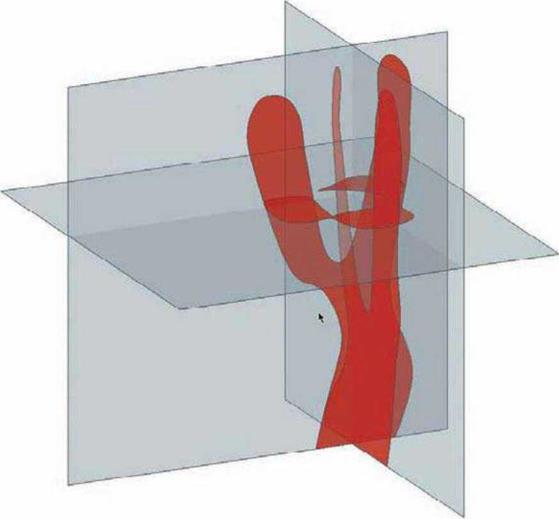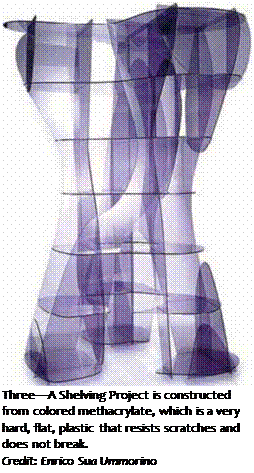 There could be no shelving unit that moves further from this paradigm than Three—A Shelving Project that Dominique jakob and Brendan MacFarlane designed for Sawaya & Moroni. “The piece came from an urge to build a completely freestanding shelving unit in space,” says MacFarlane. “The concept for the Three was to make a completely freestanding object that is both functional and spatial.” In order to fulfill this tall order, Jakob+MacFarlane did no less than reconsider space itself. “We imagined the human body as creating the space, in a sense molding the object,” MacFarlane explains. He sees the shelves as the expression of “a frozen moment in time.”
There could be no shelving unit that moves further from this paradigm than Three—A Shelving Project that Dominique jakob and Brendan MacFarlane designed for Sawaya & Moroni. “The piece came from an urge to build a completely freestanding shelving unit in space,” says MacFarlane. “The concept for the Three was to make a completely freestanding object that is both functional and spatial.” In order to fulfill this tall order, Jakob+MacFarlane did no less than reconsider space itself. “We imagined the human body as creating the space, in a sense molding the object,” MacFarlane explains. He sees the shelves as the expression of “a frozen moment in time.”
MacFarlane explains that the process of design began by imagining a transparent matrix, a three-dimensional grid, if you will. He visualized a person walking around in this space. And then, he tried to picture the shape that this person “carved out of space” as they walked. “What they leave, moving with their body in a circle, is the shape of the bookcases,” according to MacFarlane.
MacFarlane feels that this idea, as well as the ability to imagine and then create something in this way, comes directly from digital technology. “The kind of models we’re doing are digital and transparent and allow us to see through things,” MacFarlane points out. “We were interested in making real the kinds of things that you see in the digital world, looking at something almost how we’d read it as a digital model. There are ways of reading, layering, faceting, seeing something as a mesh, and this influences the vocabulary of the design object,” he continues. “Meaning that the presence, or visual vocabulary of our piece is related to a simple grid that you would give any object predigitally, by giving it the coordinates XYZ in an organic or curvilinear or fluid form. This is then the expression of those kinds of coordinates.”
The collision of design and technology is central to creation at Jakob+MacFarlane. “The digital world is a totally different process of creativity. It affects the way you think,” MacFarlane says. “It brings you into a very—both good and bad —immediacy. You see the whole thing immediately, how it could be fabricated and made. Time is compressed, and you can see it all. That gives you, in a sense, more time to both appreciate the thing and, in a sense, be more proactive in the whole fabrication phase than a designer was before. It’s so obvious that you want to fabricate it right away. Those kinds of barriers have been broken down. The designer becomes their own fabricator, and I think we’ll only be seeing more and more of this.”
|
188 DESIGN SECRETS: FURNITURE |
|
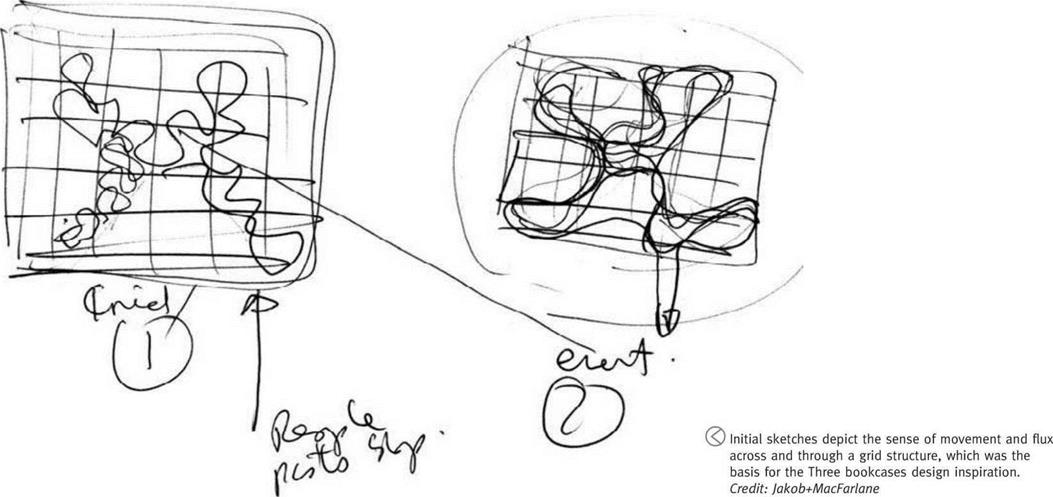
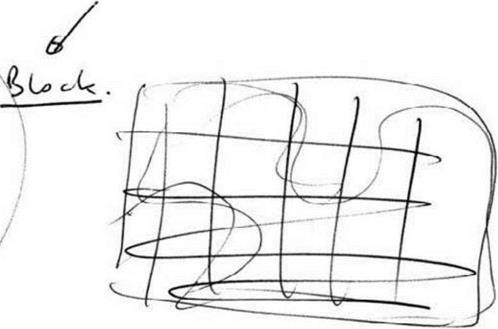
 MacFarlane feels that the Three—A Shelving Project is. . furniture made from an event. There is this idea that our everyday spaces are filled with a complexity of force fields or spatial moments created by events. Digitally, we can now capture all of these movements and make the invisible visible. In some ways we are not trying to impose a design or a preconceived object but, rather, render something visible.”
MacFarlane feels that the Three—A Shelving Project is. . furniture made from an event. There is this idea that our everyday spaces are filled with a complexity of force fields or spatial moments created by events. Digitally, we can now capture all of these movements and make the invisible visible. In some ways we are not trying to impose a design or a preconceived object but, rather, render something visible.”
Of course, there are many, extremely down-to-earth concerns when trying to make the conceptual real. Jakob+MacFarlane worked with Sawaya & Moroni on an unusual fabrication technique. MacFarlane remembers how eggs were crated back in his native New Zealand thirty years ago, with flat pieces of cardboard that were cut to slip into one another to create three-dimensional support, similar to how wine bottles are kept separate in a cardboard box. Fie created digital drawings that reflect this simple, puzzlelike mechanism. These digital drawings, showing how the bookcases would be cut from plastic set in various horizontal and vertical planes, were sent directly to the maufacturer’s cutting machinery. Once the individual pieces were made, they were assembled by hand and held together with invisibly applied screws and glue. MacFarlane points out that theoretically, the shelves could hold themselves upright simply by being slipped together, just as the cardboard divider does. But the glue and screws gives the final piece a critical measure of stability. “I think,” MacFarlane muses, “that the childhood, almost toylike aspect of putting things together is part of the interest. It’s also about revealing something that’s already assembled.”
Critical to the shelves’ success was finding the appropriate fabrication material. “The challenge was to find the right plastic,” says MacFarlane, “something that was flat enough and strong enough. Methacrylate is a very hard, flat, toughened plastic that resists scratching and doesn’t break.” Used as a shatterproof replacement for windows everywhere from hockey rinks to aquariums, methacrylate also has the advantage of retaining its translucency and making colors look particularly luminescent. MacFarlane points out that this translucency is critical to the overall design aesthetic. “We could have made it opaque, but transparency gives the object the ability to be seen all at once. In a sense, the object comes from a simple idea, but seeing it in transparency, we see something that appears much more complex than it is. This is something we’re very interested in.”
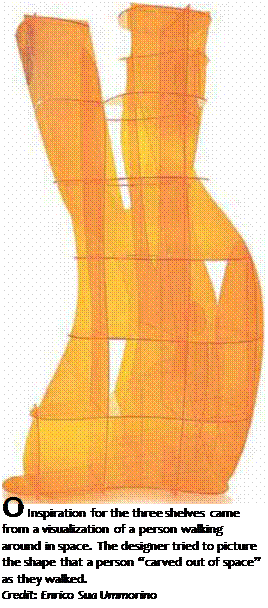 In a sense, Three—A Shelving Project is a reflection of the sculptor’s adage, which claims that a sculptor simply releases the object from the stone. As MacFarlane notes, “When working directly with the material, the material gives you the answer. Ours is more conceptual in the sense that it’s about the action of the body creating a resultant. You don’t know what to expect to see, and then something emerges.” He continues, “The strange thing about this piece is that it’s context-less. We make a big point of saying that we’re interested in context, but in this piece it’s an event that created it. The piece is an outtake of someone moving. We’ve never stated a context and never had a preconceived idea about context. The idea is what it’s all about.”
In a sense, Three—A Shelving Project is a reflection of the sculptor’s adage, which claims that a sculptor simply releases the object from the stone. As MacFarlane notes, “When working directly with the material, the material gives you the answer. Ours is more conceptual in the sense that it’s about the action of the body creating a resultant. You don’t know what to expect to see, and then something emerges.” He continues, “The strange thing about this piece is that it’s context-less. We make a big point of saying that we’re interested in context, but in this piece it’s an event that created it. The piece is an outtake of someone moving. We’ve never stated a context and never had a preconceived idea about context. The idea is what it’s all about.”
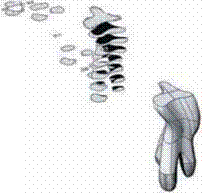 |
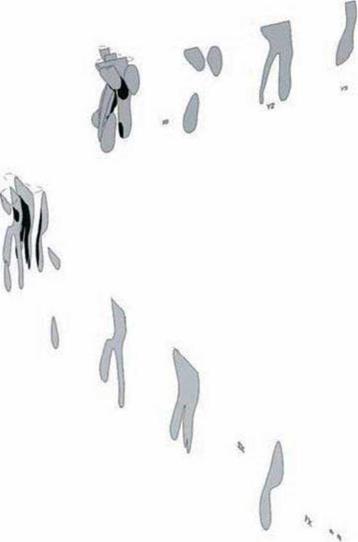 |
(2) This computer rendering reveals the unfolding of each piece that goes into the Three bookcases. Note how the central image depicts the core piece, from which the parts have been exploded across three different directions. Credit: Jakob+MacFarlane
(2) This rendering reveals what is left behind once the pieces that will become a bookshelf have been cut away. Depicting space in a three-dimensional form is a central design concept for the shelves.
Credit: Jakob+MacFarlane
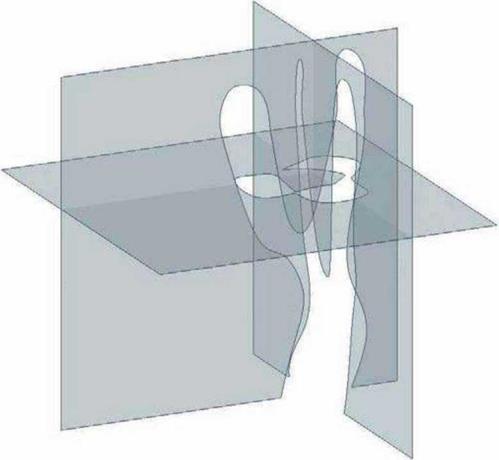 |
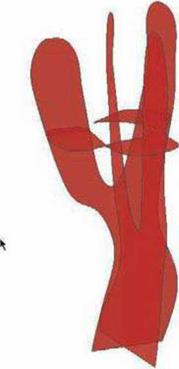 |
 Q This rendering shows both what is left behind and what was made from the three dimensional grid of methacrylate. Credit: Jakob+MacFarlane
Q This rendering shows both what is left behind and what was made from the three dimensional grid of methacrylate. Credit: Jakob+MacFarlane
![]()
|
![]()
